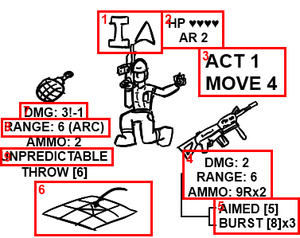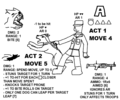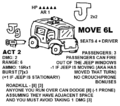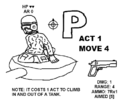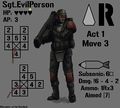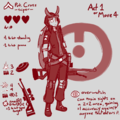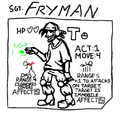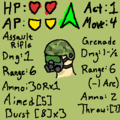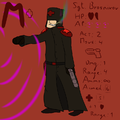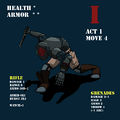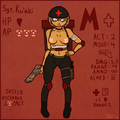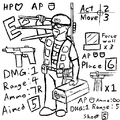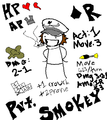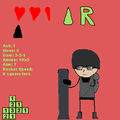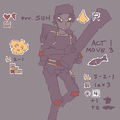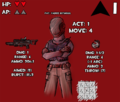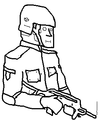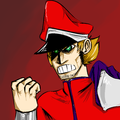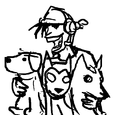Black Company
| Black Company by Samuel |
|---|
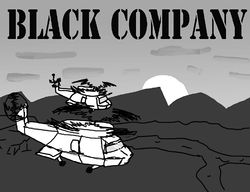
|
|
|
Black Company is a personalized, turn-based wargame where individual players join up as various classes of soldiers, and are led by their fellow suggestors in battle against GM-controlled forces in small-scale skirmishes. The enemy is commanded either by Squeegy, the author, or MrQ, also known as General Q. Waterbuffalo.
Plot
The suggestors play as members of Black Company, a division in the American military. The very first mission involved a surprise attack on a Black Company convoy by troops of the Mexican army, disguised as friendly soldiers at a checkpoint. They were slaughtered, and war sprang out between the two countries. Black Company took the fight to Zangano, the paramilitary organization that comprises the Mexican army much as Black Company comprises the United States's.
Game Progression
Much of the early fighting took place on the 4chan /tg/ board, including the initial failed mission and several missions in the first Mexican sector. /tg/ lost several battles due to poor organization, incompetent leadership and insufficient numbers. Since then, the game has been ported exclusively to tgchan, and the latest sector has been handled entirely by their forces.
Playing the Game
Each thread begins with a roll call, where all the players post their intent to play with a callsign according to their class and a name of their choice. New players may choose from the six main classes given in Codex 3, which are Infantry, Rocketeer, Telekinetic, Medic, Sniper, and Engineer. Once everyone has joined, those who have signed up as Officers (organizational and tactical support players who have no individual role in battle) are given a map with notable locations in the sector, and asked to choose which to launch an assault on. They are occasionally given support units, which players who have joined already must then be assigned to if no one steps forward to claim them. The map is then provided to the Officers, who must choose where to deploy the troops under their command, and the game begins.
Reading Stat Cards
1. This is your callsign and symbol. Your callsign is what should go next to your name when you post. For example, this soldier could be '[I] Pvt. Cann N. Fodder'. This will include a number when you're on the map (e.g. [I1]). The symbol is how you appear on the map.
2. These are your unit statistics. The [I]nfantry has 4 HP and an armor rating of 2.
3. These are your map statistics. The [I]nfantry has 1 ACT point and 1 MOVE point. This means he can move 4 spaces, and then perform an action.
4. These are your weapon statistics. The [I]nfantry rifle does 2 damage per hit, up to a range of 6, and fires 9 shots before a reload is necessary, of which it has 2. You can fire beyond your range for a penalty of -1 to-hit for each square exceeded.
5. These are your rolls. You can roll an aimed shot, which requires you to roll 5 or higher to hit, or 3 burst shots, which each require 8 or higher to hit. Each shot is rolled on a d10. Anything marked with a roll requires 1 ACT to do.
6. This is an area of effect map. It shows that the grenade damages those in a 3x3 area around where it detonates, which is marked by an X.
7. This statistic shows that multiple damage values can result from this weapon. The exclamation point next to the 3 denotes that it is the maximum, and only those hit point-blank by the blast will take that much. All those in the surrounding squares will take only 1. Most splash damage weapons will have damage maps on the card.
8. This range has a note on it that signifies special conditions.
9. Sometimes weapons or abilities will have notes that clarify their functions.
Turns
Turns in Black Company are split into Action Phase, the phase in which all troops must submit their actions, and Enemy Phase, the phase in which allied actions resolve and the enemy then makes its movements and actions. Once you have submitted an action, you are not allowed to delete or change it, though if you failed to include a roll you may do so in another post.
Each phase represents a nebulous amount of time from how long it takes to aim and fire an assault rifle, to the time it takes to sprint down a city block. In general, battles are over in minutes.
Optimal Post Syntax
Optimal Post Syntax is the best way to format your actions when submitting them, so that they can be executed without error. If you are using OPS, then you may change your action at any time by linking to the previous action and posting another action in Optimal Post Syntax. If you do not use OPS, or you use it incorrectly, then you may not change your action after you first submit it.
Move [directions] to [square]. (-# move for [pose])
([Pose change])
[Action] (dice goal) (at [callsign] on [square]).
(Modifiers: +# -# x#)
Ammo: #Rx#
(Promotion bonuses: [bonuses])
REPOST FOR EACH SUBUNIT.
Movement on the Map
Every class has a statistic called 'MOVE', which represents the amount of squares of movement that class can travel in one phase. For instance, the Infantry class has 4 MOVE, which means that they can move 4 squares every turn before committing an action. Notable movement rules:
- You cannot move after acting.
- One ACT can be spent to regain full MOVE, with a penalty of 1 MOVE for each ACT spent after the first. If a class has 2 ACT and 4 MOVE, they can sprint for a maximum of 11 MOVE.
- Even classes which normally must choose between moving and acting (i.e. the Sniper) can spend their act to sprint.
- Sprinting is considered a general term for moving faster, so the MOVE gained can be used while prone or crouched, for pose changes, and for any other normal expenditure of MOVE. This also means that vehicles can 'sprint'.
- Changing poses costs MOVE, but can have benefits as well as disadvantages. Each pose change costs 1 MOVE, and changing from standing to prone or vice versa requires 2, because you must crouch first.
- Crouching: +1 to-hit, -1 move, -1 to be hit (if on a hill)
- Prone +1 to-hit, -2 move, -1 to be hit (unless on lower ground, then +1 to be hit)
ACT and Actions
Any number enclosed in brackets on a class card (for instance, 'Shoot [5]'), signifies that it is an action, that unless otherwise stated, requires the expenditure of an ACT. You must also roll to successfully complete the action, on a 1d10, with the goal of getting the number stated or higher. If you fail an action, the author decides what happens. You will never shoot an ally with a bullet unless disoriented, but explosives are unpredictable.
ACT vs Actions
The difference between an action, and something that merely uses ACT, is illustrated in sprinting. Sprinting is considered movement, and something that while ACT is spent on it, does not count as an action. It's for this reason that snipers can sprint. The difference, fundamentally, is that actions (which also technically use ACT) end your turn. Things that use ACT are almost exclusively actions, so this nuance shouldn't come up much.
Damage and Armor Rating
The damage of each attack is labeled on its card. In general, sidearms are Dam 1 and rifles are Dam 2. Explosives are often Dam 6 with splash radiuses with lower damages. Shotguns are Dam 3 and sniper rifles are Dam 4. These can be improved with promotions, for instance you could turn your sniper rifle into a Dam 6 anti-tank monstrosity. If your AR is zero, damage is deducted directly from your HP. Otherwise, the damage is reduced according to the AR chart (available below). If you have an AR of 3 and take 6 damage, you can look at the chart across from '6 DAM' and under '3 AR', and see that the resulting number is 4, so you will only lose 4 HP.
Promotions
Every phase in which you submit an action and come out alive puts you further towards your next promotion. All new players start out at the Private rank, but after their first battle or two they will be promoted to Specialist and be permitted to improve one thing on their stat card. This can be nearly anything except for ACT, but is generally a single number (for instance, your MOVE, or your gun's damage or range, your HP, or lowering the goal on a dice roll).
- The only case where an upgrade comes at a penalty is AR, which will reduce your MOVE by 1 for each point it is raised by.
- The other exception is range upgrades, which are +2 instead of +1 for non-psychic abilities.
- Melee abilities (such as knives, stabilizing, and healing) cannot have their range improved.
- You cannot lower a die roll more than twice.
Temporary Classes
Occasionally officers will bring support along on the mission that will require a player, such as animal handlers or tanks. While playing these temporary classes, you progress towards your next promotion as normal and will continue to upgrade your normal class. However, a character can choose to attach themselves to a support class permanently, which will allow them to upgrade that class, but they will only be able to play when that support is fielded, and will lose all promotion progress.
Spec Classes
At the ranks of Sergeant First Class, and Command Sergeant Major, players have the opportunity to make a spec class. This is an entirely new class, that is related to the base class that the player specced out of in some way. The first spec is more moderate, but by the second spec the class is often only tangentially related to the original class.
Examples:
Infantry First Spec:
- Shotgunner
- Heavy Machinegunner
- Field Tactician
- Squad Leader
Rocketeer First Spec:
- Flamethrower
- Grenade Launcher
- Semtex Expert (Semtexpert?)
- MANPAD
Telekinetic First Spec:
- Hypnotist
- Clairsentient
- Psychic Blademaster
- Psychoporter
Medic First Spec:
- Knight
- Combat Medic
- Scientist
- Scout
Sniper First Spec:
- Forward Observer
- Autosniper
- Long-Range Sniper
- Archer
Engineer First Spec:
- Sentry Specialist
- Entrenchment Specialist
- Drone Engineer (Dronengineer?)
- Roboticist
Spec class limits are intentionally vague, so that players have freedom in class creation.
Death
Death is permanent in Black Company. Your character's promotion progress will be lost and their death will be mourned ICly. A soldier dies when he reaches -3 HP, and is incapacitated when he reaches 0 HP. While incapacitated, he will lose 1 HP per turn. A Medic can revive a soldier who is incapacitated if they are stabilized.
Lexicon
- Phase: The turn in which every unit on a side posts their action.
- Turn: The collection of all the game phases. These include Action Phase, Enemy Phase, and Ally Phase if applicable. Civilians move on whichever phase is representative of their nationality. At the end of a turn, all players involved gain a promotion point if they posted an action.
- Prebriefing: The pre-mission deployment of defending units.
- Deployment Phase: The initial phase of the game, where troops are deployed into the deployment zones. Proceeds immediately to Action Phase, unless the defender has the advantage, in which case it proceeds immediately to Enemy Phase, with Enemy Phase beginning each phase.
- Sprinting: The conversion of ACT into MOVE. This is considered movement.
- Stat Card: The image that contains all of the relevant stats, die rolls, and other numbers necessary to play as a class. Also known as a class card.
- Codex: The overarching ruleset and guidelines for playing. Can also refer to the image that contains the stat cards for the 6 core classes.
- Callsign: The identifying letter placed next to your name in your posts. The number is also considered part of the callsign. Having both, when necessary, is called a complete callsign. Ex. [R1]
- Symbol: The icon that represents you on the map.
- Forward: Also called the forward element, this is the Black Company-specific term for the group attempting to capture a location.
- Operator: All Black Company troops on the map are operators.
- Optimal Post Syntax: The best way to format your posts for the author's convenience. Also allows you to change your action. See Optimal Post Syntax.
Playing as an Officer
The Officer Corps is the organizational branch of Black Company, and has no physical presence on the battlefield. They handle deployment, tactics and strategy, tactical support, answer the questions of the enlisted men, and are responsible for submitting actions for anyone who fails to get them in by the deadline. As a result of all this, being an officer can be a lot of work, as they are the most important class in the game. Missions have been won and lost based on the competency of their officers alone.
Delegating Responsibilites
As an officer, you will be easily overwhelmed if you try and take every duty on by yourself. Tracking who has moved and who hasn't, the results of their actions, planning tactics for the phase, and worrying about enemies or hazards you can't see all by yourself is an intimidating prospect. For this reason, even though you get all the benefits of having officers with only one, it's much more convenient to have multiple officers. Then you can delegate responsibilities on the battlefield amongst yourself, and only have to worry about one section of the battlefield or one aspect of the fight while still being able to communicate for an overall picture.
As a lone officer, it's still a good idea to delegate some of those responsibilities among the enlisted men. If you divide them into squads, you might consider assigning squad leaders, whose job it is to keep track of movements among their own squad and report back to you. Any delegation of responsibility can make things much easier on you.
Mission Support
Before a mission begins, it may be given the opportunity to bring along one or more support options, chosen from the support page. Most can be chosen more than once.
Animal Handler
Considered either wildly overpowered or massively impotent, often depending solely on the situation they are in, animal handlers are an agile and deadly addition to almost any mission. Choosing the animal handler option will allow you to deploy with two animal handlers, who have three dog subunits each. These subunits act entirely independently of the handler, though they can only be redeployed if he is still alive. The handler is lightly armored, moving at a baseline pace, and is armed with an extremely useful non-lethal beanbag gun, which does damage through armor and stuns its target for a turn. He is generally survivable, and the two animal handlers together with their dogs can form a team of their own.
Each dog has 5 MOVE, and 2 ACT, which allows them to move up to 14 squares a turn, making them the most mobile unit currently playable. In addition to this exorbitant flanking and outmaneuvering potential, they are capable of doing some stunning of their own, and can attack targets from a range to knock them down and stun them while they and their fellow canines rip them apart. Any single unit is in extreme danger to a pack of dogs, especially the lowly [M]edic.
Armored Personnel Carrier
The APC is a useful but not essential tool in most fights. It moves at high speed, and can hold four soldiers in it as well, although they can't do anything until they get out (which they can do to any direction besides the front of the APC). It also holds an unlimited amount of ammunition which soldiers can resupply from if they are inside it, and can deploy new recruits inside it for free, although it cannot redeploy subunits, making it an effective mobile base. It can even be chosen multiple times for backup APCs, or to split forces among multiple fronts.
Jeep
A fast-moving vehicular support unit, the jeep can hold up to 5 troops, one driving, three firing their weapons normally (though at possible penalties), and one on the turret emplacement. It moves quite fast, and is hard to dodge when running people over, but can eventually start to wear down and break from damage taken doing so. Choosing this option will allow three jeeps to be deployed on the battlefield, which is enough to carry most of an army.
Note to jeep passengers: It's good etiquette to label yourself accordingly if you are in the jeep, for instance [J1][R1], so that you may be more easily identified, as you cannot be seen on the map while in the jeep.
Light Tank
Lightly armored, but swift, the light tank (or [La]), provides excellent and versatile support, like a well-armored infantry on wheels, without subtracting significantly from your forces like the jeep. Similarly, choosing this option will give you three light tanks to work with. Though highly vulnerable to explosives and even small arms fire, the light tank's machinegun is devastatingly effective against lightly or unarmored targets, as it does moderate damage at a longer range and far more accurately than an infantry, and can even fire up to a maximum of 5 times.
Medium Tank
A medium tank, while considerably slower than a light tank, is far better armored, and equipped with explosive tank shells. Though lacking as much splash as the [R]ocketeer's launcher, it is considerably more directed, and capable of firing multiple times before reloading. The medium tank is capable of surviving several point-blank explosions before being destroyed. Its moderate speed combined with its considerable firepower and decent armor makes it a good middle-of-the-road support choice.
Heavy Tank
Exactly the opposite of the light tank, the heavy tank is extremely well-armored, equipped with devastating weaponry, and moves at a snail's pace. Though it can't be counted on to keep up with the rest of the unit, and it's not especially difficult to dodge, the heavy tank is equipped with twin cannons as well as minirocket launchers. It does obscene explosive damage, though it is fairly inaccurate, so it is inadvisable for its allies to stand ahead of it. For penetrating a heavily defended area (when not in a rush), there is no superior alternative.
Officer Control Panel
Throughout the mission officers can choose to spend kills gained by soldiers on support options available in the Officer Control Panel (see below). Here is how to use them effectively. It's worth noting that only one option can be chosen per officer per phase.
Redeploy
Previously the Redeploy option was available in any phase in any location. This was phased out in favor of the Paratrooper support option in Codex 3. Redeploy is, of course, still useful for reinforcing teams that have taken fire or are at less than full strength, or who don't have enough manpower to face the enemy, but you can no longer drop your forces directly into enemy lines and have them start shooting immediately.
Redeploy, like all control panel options unless otherwise stated, is activated during Action Phase. The officer selects a square on the map, and troops are deployed in a tight spread around it. All troops will be deployed in class card condition, that is to say, standing up, fully loaded, and at full health. The option costs 2 kills per soldier, so it is unwise to drop them anywhere where they would be immediately massacred by enemy troops. Furthermore, the helicopter pilot will refuse to land within range of enemy forces and within sight of any enemy rocketeers, but this only applies to the specific square chosen by the officer. Subunits can also be redeployed with this option, such as the [A]'s dogs. They cost only 1 kill per unit.
The Paratrooper support option can be chosen at the start of a mission to make this option more viable, as it will be usable during enemy phase, allowing instant reaction, and troops can be deployed anywhere, although they will not land in as tight a spread.
Air Drop
The officer selects a square on the map during Action Phase, to drop a supply crate on the field. The supply crate costs 5 kills, and has 4 uses. It will completely refill the ammunition of any one soldier. Therefore, it is most cost effective for it to be used by soldiers who are completely out of ammunition. There is some degree of error in the supply crate's descent, and it can land up to 3 squares away from its intended target in any direction, so it's inadvisable to deploy it in a situation where it requires pinpoint accuracy for the survival of troops. The supply crates can also be accessed by the enemy, so fights may break out over them, and accidentally deploying one into enemy lines could have consequences for your troops.
UAV Recon
The officer deploys an Unmanned Aerial Vehicle for reconnoisance. This option can be chosen during any phase, although the timeliness of its deployment is rarely the deciding factor in a fight. The unmanned drone will fly over the battlefield for 3 turns, revealing all enemy and neutral structures and units on the minimap, before passing. It is extremely useful at the beginning of a fight, especially on a largely outdoor map, to prepare for the enemy and reveal bottlenecks, ambushes, and defenses that might otherwise become nasty surprises. It is also useful for checking for and tracking enemy reinforcements, and to make sure the enemy is not flanking.
Artillery
The officer selects a square on the map and specifies the amount of salvoes requested. A salvo of artillery is a single blast, and each costs 5 kills. The officer can also select multiple targets, up to one for each salvo. Salvoes can be extremely inaccurate, and vary up to 5 squares in any direction, thus making them preferable for targeting groups of units or multi-square units rather than individual units, which may be missed even by the artillery shell's wide splash radius. Artillery is also useful for busting and crippling enemy tanks, although even a direct hit to an enemy Medium or Heavy Armor will not destroy it if it was previously undamaged, and the Light Armor's smaller size makes it harder to hit reliably. The artillery is also useful for softening outdoor enemy defenses, and several salvoes can devastate a fortified position. An artillery strike will hit at the end of the Action Phase it is called during. Artillery cannot penetrate buildings.
Air Strike
The officer draws a straight line through the map, and a bomber will fly overhead, and carve a swathe of destruction across the map, doing massive damage to everything in its way. The air strike is completely accurate, and will never vary from the line that is drawn for it, but the splash damage is relatively minimal. Though its path can be targeted to get the most destructive potential for the 20 kills that it costs, it is most useful for decimating enemy lines, groups, or accurately targeting enemy armor, although collateral damage must be taken into account, as the air strike does not discriminate between friend or foe or anything inbetween.
Playing as a Soldier
As a soldier, you have a duty to follow your officer's instructions, but strictly speaking, you don't have to. Often times the officer will give a general plan rather than ordering soldiers specifically, and it is your responsibility to interpret those orders in your action. There's a reason you submit your action directly.
Infantry
The [I]nfantry unit is the most effective and versatile class. With the most HP, and baseline ACT and MOVE despite their decent AR, they are survivable without being specialized, and their rifle and grenades allow them to be prepared for any situation. They are especially skilled in breaking up fortifications, however, and scattering support. Because of their versatility and relative simplicity, there are often more [I]nfantry than any other class on missions.
The [I]nfantry comes equipped with a rifle capable of both single and three-round burst fire. It does baseline damage, which makes it mediocre against more heavily armored enemies, but its burst mode makes it formidable against other units, especially those with baseline or lower HP, or no AR. It is exceptional for eliminating high-value targets, or for gambling against the dice to kill an enemy with higher HP in a single phase. Their grenades can breach fortifications, dissolve blockades, and soften groups of enemies, and are capable of ignoring cover that otherwise could pose a serious threat.
Rocketeer
The [R]ocketeer unit is an impressive damage-dealing explosives expert. They are capable of providing heavy support, and their armor makes them hard to get rid of, though they cannot move as fast as other units. They are most useful for taking out enemy armor, and disrupting bottlenecks and killing floors, but a direct hit from their rocket will take out any base class, including other [R]ocketeers.
Their only weapon is their rocket launcher, but it is unmatched in sheer damage-dealing potential. Its splash damage can kill whole groups of enemies, and it has no hard range, but rather travels at a rate of 6 squares per phase, meaning it will simply take time to reach its destination. The downside to this is that shooting past 6 squares gives the enemy the opportunity to dodge the rocket, but they can compensate for this by aiming at the ground rather than directly at an enemy, at the expense of some direct damage. The [R]ocketeer is also useful for creating extemporized doorways to allow troops to bypass normal entrances.
Telekinetic
The [T]elekinetic unit is a fearsome glass cannon. Though entirely exposed on the battlefield, they are equipped with a variety of psychic powers to allow them to survive even when they wade directly into fire, though it's not any more recommended. The [T]elekinetic is more of a stealthy class than one might think, and often relies on ambushes and covering fire to close the distance. They are also primarily a support class, and can aid their allies by immobilizing high-value targets and nullifying cover.
The most personally useful power of the [T]elekinetic is the ability to provide a psychokinetic shield for themselves as a passive action. This can help them get to and through the front lines, but its usefulness does not extend into battle itself, as the [T]elekinetic will be unable to use any other power at the same time. They can also use their powers to damage an enemy's internal organs, and cause internal bleeding and hemorrhaging, while bypassing armor, making them a serious threat to any single unit except the [I]nfantry, and indispensable for eliminating enemy armor. Finally, they can lift enemies out of cover and immobilize them, at a further range than they could hurt them, which is useful for supporting allies without putting the [T]elekinetic in danger.
Medic
The [M]edic unit is a vital support class. Battles can be won or lost based on their [M]edic content alone. Even attaching one to a squad can increase its life expectancy drastically, and if not keep them fighting at least prevent them from dying. The [M]edic is an extremely mobile unit, able to speed across battlefields to wherever they are needed. They are, however, primarily a support class, and consequentially they are not apt at dealing damage. Their sidearm's damage is inconsequential at best. Their biggest boon, however, is their directional shield, which keeps them alive as they traverse the front lines. Keeping it pointed towards the enemy will protect them from even the worst explosions, though the [T]elekinetic can still strike fear into a [M]edic. They are also extremely vulnerable to being flanked, and to fast-moving units such as the [A]nimal Handler's dogs.
The [M]edic laser pistol does not do a great deal of damage, and has limited range, but its unlimited ammo makes reloading not an issue for them, allowing them to save their ACT for sprinting, healing, and recharging shields. They can heal anyone, including themselves, and receive a bonus to stabilizing incapacitated units. They can even revived downed soldiers once they've been stabilized, keeping an army running even when everyone in it should be dead. Their shield also allows them to traverse dangerous battlefields and survive close encounters with the enemy, as it absorbs overflow damage, although as it is directional, they are at serious risk if flanked, as their lack of armor is necessary for their speedy movement, and they will fall quickly to surprise attacks.
Sniper
The [S]niper unit is a devastating long-range attack class. Though hampered by their inability to move before acting, they are extremely accurate, and their high-powered sniper rifle can one-shot most base classes. They are best suited to positions where they can fire on enemies without having to move much, and can prepare their bonuses, such as manning bottlenecks, barricades, and killzones. However, they will often have difficulty keeping up with the rest of their unit, and in exposed situations can come under fire while moving or reloading. They are also weak in cramped, urban situations, where their range is not an advantage and they can be easily ambushed, flanked, or picked off when they fall behind.
Under perfect conditions, it is impossible for the [S]niper to miss with their rifle. The class-specific +1 for being prone, along with the normal +1, and a +1 for Overwatch zones, mean that the [S]niper will always hit a normal standing enemy. If penalties exist, the [S]niper is even more likely to hit them on their next shot. As well, the long range allows them to pick off enemies before they can become a threat. In addition, they can lay down mines without a roll, allowing them to set up defended positions for them to snipe from. A bunkered [S]niper poses a serious problem to any squadron.
Engineer
The [E]ngineer unit is a fortification and bunkering specialist. They can instantly create entrenched positions on the front line, and provide vital cover for units under fire. Their walls can turn the tide of a fight by giving the advantage of one-way cover to his side, and they can create bottlenecks and killing floors to ambush unwary enemies. In addition, they can set up defensive positions and control turrets in them remotely, allowing them to guard areas without even being in them.
Though the [E]ngineer's machine pistol is subpar, they can essentially upgrade it by placing a turret and using it instead. The turret can also be used to remotely guard positions even after the [E]ngineer leaves. He can support his allies by throwing smoke grenades to allow them to pass through enemy killing zones unmolested, or use them to cover himself while he sets up his constructions. He can set up impromptu defenses anywhere on the battlefield, and is vital to moving as well as holding the line.
Rule Database
This is a database of frequently asked questions about the game. Please check here before asking.
Miscellaneous
- You are allowed to create as many characters as you like, however no two can be in the same battle at once.
- You can shoot past normal range at a penalty of -1 to-hit for each square exceeded, unless the range is 1 or you are a [T]elekinetic.
- You can move through friendly units, but not stand on top of them.
- Blue circles are civilians.
- Diagonals are identical to cardinal directions for the purposes of movement and range.
- Soft cover is cover you must crouch behind to be protected. Hard cover is cover you simply must move behind.
- Reloading costs 1 ACT.
- Facing a corner will allow you to see (but not shoot) around it without exposing yourself.
Class Cards
- Arc: Any weapon marked with (Arc) can be arced to ignore cover at a -1 range and -1 to-hit penalty.
- Subsonic: Any weapon with a subsonic range moves the given number of squares per phase.
- Tank Shock: Anyone the tank passes over must roll at least the given number to dodge out of the way (if possible).
- Roadkill: Anyone the car passes over must roll at least the first number to dodge out of the way (if possible). The driver must roll at least the second number to avoid taking 1 HP damage.
- Subunits cannot stabilize or use knives.
- Subunits cannot deploy from an APC, but can be redeployed for half the cost.
Infantry
- The Infantry's grenade will not land where he throws it if he fails his roll; it will vary up to 3 squares in any direction.
Rocketeer
- The Rocketeer's rocket's movement is based on the straightest line between the Rocketeer and the target location, not the direction the rocket is facing when the phase ends.
- The Rocketeer's rocket will not hit where he aims if he fails his roll; it will vary up to 3 squares in any direction.
Telekinetic
- Tanks are considered armor for their pilots.
- Shields are considered cover for their medics.
- Psychic abilities can't have their range extended.
- Psychic abilities ignore hard and soft cover, as long as the Telekinetic or an ally can see the target.
- The Hurt power ignores armor, dealing direct HP damage.
- The Lift power can only lift troops, but it can stop subsonic projectiles in midair.
- The Shield power requires 1 ACT, and counts as an action.
Medic
- Recharging the shield requires 1 ACT, and counts as an action.
- Moving the shield to any direction requires 1 MOVE.
- The medic cannot heal any downed soldiers who are not stabilized.
- A stabilized soldier the medic heals is revived.
Sniper
- The sniper's Overwatch ability can be activated at the end of any turn, and is deactivated when they move.
- The sniper cannot move in the same turn that she acts.
- The sniper receives a +1 bonus when they shoot at a target more than once in a row. This applies to aimed and quickshots.
Engineer
- Shields and force walls will block all damage before they are destroyed.
- The engineer and his allies can shoot through allied force walls. This applies for enemies and their force walls too.
- Turrets are soft cover and force walls are hard cover.
Vehicles
- Tanks can punch through walls if they have at least 1 Length worth of lead up.
- Anyone a vehicle runs over gets a free hit on the vehicle before they are hit.
Codex and Cards
Custom Cards
Fanart
| Quests by Samuel |
|
Active: Completed: Prototype | Moulder's Journey Dormant: Venturing Underground | Decisions | StealthQuest | Cast Quest | Does This Thing Work | Phantom Star | Red Tape | Zalgo Quest | Kzeytch | Rat Quest | Sunken Stars | Psychogenic | Edge of the Void | Domicile | Puzzle Dungeon | Black Company | The Unkindness of Ravens | Age of Shadows Other notable creations: TGMUD | Python Strip Poker Adventures |
